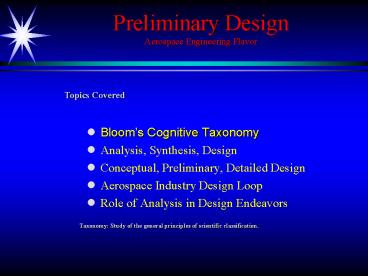Blooms Cognitive Taxonomy - PowerPoint PPT Presentation
1 / 11
Title:
Blooms Cognitive Taxonomy
Description:
Taxonomy: Study of the general principles of scientific classification. ... 2D Airfoil. 3D Wing/Body. Cdo (M,CL) CLa , e (Stability. Derivatives) (ControlSurface ... – PowerPoint PPT presentation
Number of Views:78
Avg rating:3.0/5.0
Title: Blooms Cognitive Taxonomy
1
Preliminary DesignAerospace Engineering Flavor
Topics Covered
- Blooms Cognitive Taxonomy
- Analysis, Synthesis, Design
- Conceptual, Preliminary, Detailed Design
- Aerospace Industry Design Loop
- Role of Analysis in Design Endeavors
Taxonomy Study of the general principles of
scientific classification.
2
Blooms Cognitive Taxonomy
Level 1 Knowledge Recalling
factual information.
Level 2 Comprehension Using information
Level 3 Application Applying
principles
Level 4 Analysis
Explaining relationships/ making inferences
Level 5 Synthesis Making
predictions/create
Level 6 Evaluation Making
judgments or stating options
From Project LEA/RN - Iowa State University
3
6 Evaluation Ability to
judge the value of ideas, procedures, meth- ods,
etc. using ap- propriate criteria
Levels of Cognitive Ability (Blooms Cognitive
Taxonomy)
5 Synthesis Ability to put
to- gether parts into a new, unified whole
Requires synthesis
From Project LEA/RN - Iowa State University
4 Analysis Ability to
break down material into its parts or
to determime rela- tions among the parts and
the ways they are organized
Requires analysis
Requires analysis
3 Application Ability to
use gen- eralizations in new and concrete
situations
Requires application
Requires application
Requires application
2 Comprehension Ability to
apprehend what is being commu- nicated and make
use of the idea without re- lating it to other
ideas or materials or seeing fullest meaning.
Requires comprehension
Requires comprehension
Requires comprehension
Requires comprehension
1 Knowledge Ability to recall,
to bring to mind the appropriate material
Requires knowledge
Requires knowledge
Requires knowledge
Requires knowledge
Requires knowledge
4
Analysis, Synthesis and Design
Analysis
Given the operating system and its operating
environment, determine the operating and
performance characteristics.
Example
Given an airplane configuration
(I) GTOW (ii) Propulsion system
characteristics (iii) Wing area (iv)
Cdo (v) Span efficiency factor and
(vi) Standard atmosphere
Determine
The airplane performance characteristics (I)
Level steady cruise speed (ii) Static climb
rate (iii) Service ceiling (iv) Stall
speed
5
Analysis, Synthesis and Design
Synthesis
Given the operating environment and the operating
and performance characteristics to be achieved,
determine the system
Example Given the desired performance
characteristics (I) Max speed
(ii) Altitude at max speed and
(iii) Standard atmosphere
Determine (I) The airplane
configuration definition (ii)
GTOW (iii) Configuration geometry
(iv) Propulsion system (iv) etc
and (v) Other performance
indices
6
Analysis, Synthesis and Design
Design - Repeated synthesis or analysis to
determine the system that will provide an
optimal (max or min) performance characteristic
given the operating environment and other
operating and performance characteristics
Example Given the desired performance
characteristics (I) Max speed
(ii) Altitude at max speed (iii) Range
(iv) Payload (v) Field length
and (vi) Standard
atmosphere
Determine The airplane configuration (I)
GTOW (ii) Configuration
geometry (iii) Propulsion system (iv)
etc and (v) Other
performance indices for which time to
climb to a given altitude is minimum.
7
Conceptual and Preliminary Design
With respect to the task of moving groups of
people from point A to point B ---
Conceptual Design - It would be great to have an
airplane, but a bus will
do the job!
Preliminary Design - Which bus will do the job
best?
Note that the conceptual design tasks are
generally left to the older and and more
experienced staff in a company. They have a keen
sense of the general overall capabilities of the
organization and a good feel for the marketplace
associated with their potential products.
On the other hand, the execution of the more
sophisticated analyses in the prediction of a
proposed systems performance is generally left
to younger, more recently studied staff.
8
The Design/Prototype/Testing/Manufacture Loop In
An Aircraft Company
Preliminary Design Group
Design Loop
Proposed configuration
9
From Scientific Research to Engineering Support
to Product
10
(No Transcript)
11
Designer Responsibilities
1. To provide management with a realistic
schedule showing major milestones and
corresponding completion dates for his/her
design effort. 2. To provide management with the
best possible (optimal) solution to the
design problem consistent with the given
time and monetary constraints.































